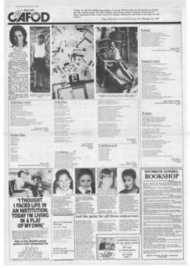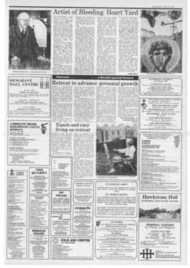Page 12, 12th June 1987
Page 12

Report an error
Noticed an error on this page?If you've noticed an error in this article please click here to report it.
Tags
Share
Related articles
Lay Groups On Synod Agenda
Putting The Synod In Perspective
Women Axed From Synod Summary
The Debate On Lay Apostolate
Ten Years Of Change Since Vatican Ii
Why not elevate laity this year?
IN PREPARATION for the coming Synod on The Role of the Laity in the Church and in the World 20 years after Vatican II the Holy Father has said: "The Council did not intend simply to allude to all those who are not priests or religious, as if emphasising, in a negative sense, that the laity are those who do not belong to these categories. No, the Council opens up a truly positive view. It is seen from the point of God's plan contained in Revelation. It responds that the laity, together with the hierarchy, clergy and religious are the People of God . . .
This people is the Church: it is a united and ordered people. It is not a shapeless mass, a conglomeration of individuals travelling towards different destinations. It is a true people, a gathering of Christian men and women who recognise their common origin in the same divine paternity, their common journey on the one path which is Christ the Redeemer."
Pope John Paul II went on to say: "The laity are in all ways members of this privileged people, which constitutes a lasting and sure seed of unity .. . for the whole human race . . and is also used by (Christ) as an instrument for the redemption of all, and is sent forth into the whole world as the light of the world and the salt of the earth. In it there is no equality on the basis of race or nationality, social condition or sex; as members, they share a common dignity from their rebirth in Christ."
This being so, it is surprising in this year of the synod of the laity that there is, so far, little sign of laymen and laywomen, least of all married laymen and laywomen, being beatified or canonised by the Holy Father.
To date, the emphasis would appear to be on declaring clergy and religious as saints or beati. True, in the 85 Beati for Britain this year, there are some 20 laymen. It would be a pleasant surprise for the laity if the Holy Father marked this year by beatifying or declaring a saint, some men and women, some of them married, "who have the same filial grace and same vocation to perfection" as priests or religious.
One possible laywoman candidate who comes to my mind is Edel Quinn, the young, frail Irish girl who became a legendary lay missionary in African lands. She was born in Ireland, at Greenane, near Kanturk, in County Cork, on the feast of the Exaltation of the Cross in 1907. Her life was one long communibn with the crucified Christ. She died in Nairobi on May 12, 1944.
Another shining example of a layman candidate for Edel Quinn, at the age of 28, on the eve of her departure to the African missions.
beatification or canonisation, for my money, would surely be the Dublin labourer, Matt Talbot, born in 1856, and who died in 1925. He was educated, until he was 12 years of age, by the Christian Brothers. After an early life of total alcoholism he turned to a life of prayer at the age of 27, after reading the writings of St Augustine.
He worked for a pittance in the timber yards of T. and C. Martin in Dublin (Mother Mary Martin's family firm), lived in a tenement, and spent every penny he earned on drink up to the time of his conversion. Despite very little formal education he was conversant with the writings of the great mystics, and particularly with the penitential exercises of St Catherine of Siena and St Teresa of Avila.
After his reform, he attended mass every day, sometimes the first Mass in the church of the Jesuit Fathers, St Francis Xavier's in Gardiner Street in Dublin. Frequently the devil was on his back, trying to prevent him from entering the church as he knelt on the steps outside the church, waiting for the doors to open.
He slept on a plank bed with a block of wood for a pillow. He fell dead in a Dublin street, on June 7, 1925 while on his way to morning Mass in the Dominican Church, and was taken to Jervis Street hospital. There it was discovered that he wore penitential chains which had become embedded in his frail body. If you want to read more about him the best life has been written by the Irish Catholic writer, Mary Purcell.
Matt has had a new bridge across the River Liffey in Dublin named after him. Perhaps the Supreme Pontiff, the ultimate bridge builder between here and eternity, would take a second look at his cause this year?
Catholic Worker
I have often thought what a novel gesture it would be if the Supreme Pontiff, on one of his trips to the United States, were to visit the house of hospitality of the "Catholic Worker" at 36 East First Street in New York. In this year of the laity there are many American Catholics who would like to see the beatification of the foundress of the "Catholic Worker" movement, the saintly Dorothy Day, who died in 1980.
When I lived in New York I saw for myself the homeless who slept on subway grates for warmth in the winter. I saw the decayed waste lands of the Big Apple, the rat-infested, unheated tenements where the "marginalised" people of many races existed, surrounded by abandoned and burnt-out shells of former tenements.
Today there are 60,000 homeless in New York City and 200,000 on the waiting list for public housing. These people do not make the headlines in the year of the laity, but many of them are aware that because of t he "Catholic Worker" somebody holds out hope for them and prays with them.
The "Catholic Worker" still promotes the clear thoughts of Peter Maurin, co-founder of the movement with Dorothy Day. Peter died in 1949. He had the clearest mind of any Catholic social writer of our time.
Here for t xample, from his "Easy Essays" are his concluding thoughts on Legalised Usury.
"Because John Calvin legalised money-lending at interest, the State has legalised money-lending at interest. Because the State has legalised money-lending, home-owners have mortgaged their homes.
Because the State has legalised money-lending at interest, farmers have mortgaged their farms.
Because the State has legalised money-lending at interest, congregations have mortgaged their churches. Because the State has legalised money-lending at interest, institutions have mortgaged their buildings.
Because the State has legalised money-lending at interest. Cities, Counties, States, and the Federal Government have mortgaged their budgets. So people find themselves in all kinds of financial difficulties because the State has legalised money-lending at interest."
Prayer
In this year of the laity I am reminded also of the Womens' World Day of Prayer. It is now the largest single ecumenical movement in the world, and was started in the United States one
blog comments powered by Disqus













